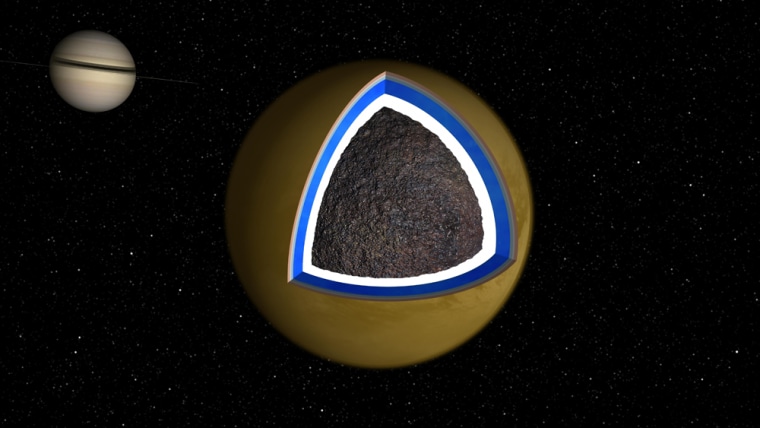An ocean seasoned with the chemical ingredients of life may lie hidden beneath the icy surface of Saturn's moon Titan.
The evidence? The entire surface of Titan appears to be sliding around, scientists say, like cheese over tomato sauce on a slice of pizza.
Titan is the largest of the more than 50 known moons orbiting Saturn, and is in fact bigger than the planet Mercury. Titan possesses a thick, planetlike atmosphere — the only moon in the solar system known to have one. And the Cassini-Huygens mission to Saturn and its moons revealed a surface at Titan covered with icy mountains, oily lakes and seas and what might be "cryovolcanoes" that spew plumes of water and ammonia.
Scientists had long suspected that an underground ocean might exist on Titan, much like the ones thought to exist on Jupiter's moons Ganymede, Callisto and Europa.
"Models of heat flow in Titan's interior suggested years ago that Titan would likely have an internal water or water-ammonia ocean," said Ralph Lorenz, a Cassini radar team member at the Johns Hopkins University Applied Physics Laboratory in Laurel, Md.
Lorenz and his colleagues analyzed several years' worth of radar data from the Cassini-Huygens mission. They found evidence that some features on the moon's surface had drifted.
"As we were mapping Titan's surface, we were building maps up in little strips. Some of these strips overlapped, help tying the map together, but when you looked at where the features were in one strip compared with another strip, the coordinates weren't the same," Lorenz explained.
Rock 'n' roll moon?
Their research suggests that winds in Titan's dense atmosphere might actually rock the moon back and forth on its axis, influencing how it spins. The winds can accelerate the small moon's rotation speed and then, as the winds change with the seasons, they can decelerate it.
Slideshow 12 photos
Month in Space: January 2014
"Titan's winds should spool up and spin down with the seasons, and because Titan's atmosphere is so massive and Titan is relatively small, the winds have a measurable impact on Titan's rotation," Lorenz said. "If you adjust the parameters of how Titan rotates very slightly, we could make the features on the maps match up."
Winds actually sway the rotation of Earth too, changing the length of the day by roughly 1 millisecond over the course of the year. "But Titan's atmosphere is so massive and its crust is light, so the changes are much bigger there," Lorenz explained.
The size of these shifts hints that Titan's crust and core have to be separated by a liquid ocean to allow the atmosphere to move the crust around. Titan is about 3,200 miles (5,150 kilometers) in diameter. The hidden ocean may be 60 to 120 miles (100 to 200 kilometers) thick, and its ice crust may be 30 to 90 miles (50 to 150 kilometers) thick, Lorenz said. Beneath that may be a few hundred miles of a heavier form of ice "that you get at higher pressures," he explained, on top of a rocky core roughly 1,800 to 2,100 miles (3,000 to 3,400 kilometers) wide.
Water with a dash of ammonia
This underground ocean is likely mostly water with a dash of ammonia. As organic molecules — the chemical ingredients of life on Earth — have been detected on Titan's surface, it may be they are in the ocean as well.
"Whether life has ever evolved on Titan is another question, but whether it did or didn't, Titan can tell us about the chemical processes that ultimately lead to life," Lorenz told Space.com.
Cassini may make magnetic and gravity measurements that show more evidence of an ocean, "but in the future it would be ideal to put a long-lived lander on Titan with a seismometer to detect the ocean that way," Lorenz said. "ESA and NASA are right now evaluating such a mission for launch in the 2017 timeframe."
However, there might be another explanation other than a hidden ocean behind these findings. Titan might have a reoccurring wobble in its orbit, said NASA Jet Propulsion Laboratory planetologist Christophe Sotin, who did not participate in this study. To confirm if Titan has an underground sea or not, Sotin said, Cassini would need to observe that moon for another six years to see if its spin slows down, as would be expected if there was a subterranean ocean.
"If there is the presence of an ocean there, with a pressure and temperature very similar to Earth's oceans, the question of life is now open for Titan," Sotin said.
Lorenz and his colleagues detail their findings in Friday's issue of the journal Science.
Space.com staff writer Andrea Thompson contributed reporting to this story.

